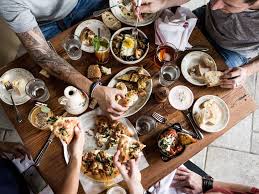Eating, the Italian way

Rome: You go straight to the heart of the matter when you say that you have noticed some discrepancies in the eating habits of different families and people around Italy.
The fact is that everyone has different routines: however, there are some patterns and eating habits that we all have in common.
For example, I would say that you have always had antipasto (starter), primo (first, usually pasta-based course), secondo (second, usually meat or fish-based course), contorno (side-dish) and dolce (dessert) with your relatives exactly because you were with them: family lunches and dinners always have to be special.
You have to impress your hosts by entertaining them with food. And woe to you if you don’t throw a feast: at the end of the meal you must be completely full! You know, sharing lots of food is our way of making someone feel welcome.
But unless it is a special occasion — your relatives are visiting you; you invited your friends for dinner; your grandmother has decided to cook for you — you really don’t have time to prepare a meal with all those courses during the week. As you said, we keep it more casual, while in the weekends— especially for Sunday’s lunch — we usually do have a full meal. I would say that what our typical eating routine includes:
A sweet breakfast: the most common combo you go for in a bar is a cornetto (or brioche, pasta, croissant: whatever you like to call it) e cappuccino!
a break before lunch: you’ll take a break from work drinking a coffee with your colleagues or you’ll eat your merenda if you’re at school.
Lunch between 12:30 and 2/3 pm. Of course, you’re free to have whatever you like for lunch, but as a general rule: a panino (not a panini, if it’s only one) is an easy fix; if you prefer to eat in a trattoria, a restaurant or a bar you will usually find lunch menus which offer a primo e contorno or secondo e contorno option, accompanied by some wine and a coffee at the end; at home too, we usually have a main course (may it be pasta or meat) plus some fruit and vegetables. Lunch is the most important meal of the day: if you go outside the main cities, you’ll also discover that shops usually close at lunchtime, so that everyone can have a proper meal and rest until about 4:30 pm.
But life is getting busier everyday, so you can’t expect each and every Italian to organize themselves in the exact same way.
Dinner between 7:30 and 9:30 pm: If you have had a filling lunch, you’ll go for a lighter dinner. But again, this is completely up to you.
There are no rules about what happens between lunch and dinner: there’s no such thing as an ‘afternoon tea time’ and you can eat a snack if you feel like it, but you are also completely free to skip it if you’re not hungry. Personally, I love to have a slice of pizza from a pizzeria al taglio when I’m feeling peckish in the afternoon.
Aperitivo is a good way to meet your friends in the late afternoon (even though you can also have it before lunch): this can range from a drink (the most common one is Spritz cocktail, but you can choose whatever you prefer) accompanied by nibbles or more elaborated dishes that make it basically a dinner. This latter we call apericena.
To sum it up, we can say that traditionally we have very specific set times for our meals. But in practice, these can shift slightly from one person to another and from one place to another.
As to what we eat, well, the Italian cuisine is so rich and varied that I’m not sure I’m able to give you a concise and satisfying answer. But I would say that we do love pasta and eat it often, and that we don’t like to mix everything in a single dish: we tend to keep primo, secondo and contorno separate, even though we don’t always have them all in a single meal.





